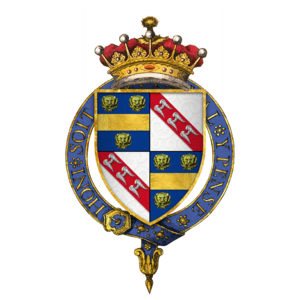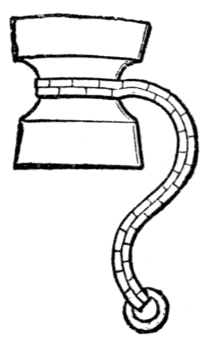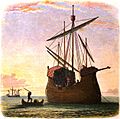William de la Pole, 1st Duke of Suffolk facts for kids
Quick facts for kids
William de la Pole
|
|
|---|---|
| 1st Duke of Suffolk | |

William de la Pole's coat of arms when he became a Knight of the Garter.
|
|
| Born | 16 October 1396 Cotton, Suffolk, England |
| Died | 2 May 1450 (aged 53) English Channel (near Dover, Kent) |
| Buried | Carthusian Priory, Hull |
| Spouse(s) | Alice Chaucer (1430–1450, widowed) |
| Issue | John de la Pole, 2nd Duke of Suffolk Jane de la Pole (illegitimate) |
| Father | Michael de la Pole, 2nd Earl of Suffolk |
| Mother | Katherine de Stafford |
| Military service | |
| Allegiance | |
| Service | 1415–1437 |
| Conflicts |
Hundred Years' War
|
William de la Pole, 1st Duke of Suffolk (born 16 October 1396 – died 2 May 1450), was an important English leader and military commander. He lived during the Hundred Years' War between England and France.
William de la Pole became a close friend of the weak King Henry VI of England. This made him a very powerful person in the English government. However, he was blamed for many of the government's problems, especially the difficult war in France.
He fought in many battles during the Hundred Years' War. He was one of the English commanders at the Siege of Orléans, which England lost. William de la Pole believed that talking and making peace was better than fighting. This idea was popular with King Henry VI.
Later, he became a very important figure in the government. He helped arrange the Treaty of Tours in 1444, which was a peace agreement. He also helped set up the king's marriage to Margaret of Anjou. Towards the end of his career, many people accused him of mismanaging things. He was forced to leave England. While traveling by sea, he was captured by an angry group, given an unfair trial, and killed.
His lands were taken by the King, but they were later given back to his only son, John.
Contents
Early Life and Military Career
William de la Pole was born in Cotton, Suffolk. He was the second son of Michael de la Pole, 2nd Earl of Suffolk. His mother was Katherine de Stafford.
William spent most of his early life fighting in France. He was badly hurt during the Siege of Harfleur in 1415. His father died from illness during the same siege. Later that year, his older brother, Michael, was killed at the Battle of Agincourt. This meant William became the 4th Earl of Suffolk.
He continued to serve in all the later French campaigns for King Henry V. Even though he was young, he held important positions in Normandy between 1421 and 1422.
In 1423, he joined Thomas, Earl of Salisbury in France. He fought bravely at the Battle of Verneuil in 1424. For the next four years, he was Salisbury's main assistant in leading the war. After Salisbury died, William became a co-commander of the English forces at the Siege of Orléans in 1429.
When Joan of Arc helped the French lift the siege in 1429, William retreated to Jargeau. He was forced to surrender there on June 12. He was captured by a French soldier named Guillaume Renault. William admired the young soldier's bravery so much that he made him a knight before surrendering. This moment is famous in French history. William was a prisoner of King Charles VII for two years. He was finally set free in 1431 after fourteen years of continuous military service.
Rise to Power and Political Influence
After returning to England in 1434, William de la Pole was made Constable of Wallingford Castle. He became a close friend and helper of Cardinal Henry Beaufort. Even though some peace talks failed, the Cardinal's power remained strong. William gained more and more influence in the government.
His most important achievement during this time was arranging the marriage of King Henry VI to Margaret of Anjou in 1444. He managed this even though he was not keen on it at first. The agreement also included a two-year truce. For this, he was promoted from Earl to Marquess of Suffolk. However, a secret part of the deal gave some French lands, Maine and Anjou, back to France. This later caused big problems for him.
In 1447, both Humphrey, Duke of Gloucester (who died after being arrested) and Cardinal Beaufort passed away. William de la Pole then became the main person in charge behind the weak King Henry VI. He quickly received many important jobs, like Chamberlain and Admiral of England. He was made Earl of Pembroke in 1447 and Duke of Suffolk in 1448. However, some people suspected Suffolk was involved in Humphrey's death. He was also later accused of being a traitor.
William de la Pole had powerful enemies, including John Paston. Many people blamed his followers for causing trouble in East Anglia.
Downfall and Death
The next three years saw England lose almost all its lands in northern France, including Rouen and Normandy. William de la Pole was blamed for these losses. This was partly because of the secret deal that gave Maine and Anjou back to France. When Parliament met in November 1449, his opponents showed their strength. They forced the treasurer, Adam Moleyns, to resign.
Moleyns was killed by sailors in Portsmouth in January 1450. William de la Pole knew that he would be attacked next. He bravely spoke to Parliament, reminding them of his long and honorable service. However, on January 28, he was arrested and sent to the Tower of London. He was then accused of crimes by the Commons in Parliament.
The King tried to protect his friend. William was banished from England for five years. But on his journey to Calais, his ship was stopped by another ship called the Nicholas of the Tower. William was captured, given an unfair trial, and killed by beheading.
His body was later found on the sands near Dover. It was probably taken to a church in Suffolk, possibly Wingfield. However, he was buried in the Carthusian Priory in Hull by his wife Alice, as he had wished. This Priory was founded by his grandfather in 1377. Most of its original buildings were destroyed during the English Civil War.
Before he left for exile, William de la Pole wrote a letter to his young son, John, who was only 8 years old. This letter still exists today and helps us understand what he was like.
Family Life
William de la Pole married Alice Chaucer on November 11, 1430. Alice was the daughter of Thomas Chaucer and the granddaughter of the famous poet Geoffrey Chaucer.
In 1437, King Henry VI allowed William and Alice to set up a special charity. They created a chantry (a place for prayers) and an almshouse (a home for poor people) for thirteen men in Ewelme. They gave land in Ewelme and other counties to support this charity. This charitable trust still exists today.
William de la Pole had one known son with Alice:
- John, who became the second Duke of Suffolk in 1463.
William also had an illegitimate daughter named Jane de la Pole. Her mother was said to be a nun named Malyne de Cay. Jane de la Pole (died February 28, 1494) married Thomas Stonor before 1450.
His Nickname: Jackanapes
William de la Pole was sometimes called "Jackanapes." This nickname came from "Jack of Naples," which was a slang term for a monkey back then. This was probably because of his personal symbol, called a heraldic badge. His badge showed an "ape's clog," which was a wooden block chained to a pet monkey to stop it from running away.
The word "jackanape" later came to mean a rude or overly confident person. This was because many people saw William de la Pole as someone who had become rich and powerful too quickly. His great-grandfather had been a wool merchant from Hull, not a noble.
William de la Pole in Stories

William de la Pole is an important character in two plays by Shakespeare:
- In Henry VI, Part 1, Shakespeare shows him arranging the marriage of King Henry and Margaret. In Shakespeare's play, Suffolk falls in love with Margaret and arranges the marriage so they can be close.
- His downfall and death are shown in Henry VI, Part 2. Shakespeare changes history a bit by having King Henry banish Suffolk for being involved in the death of Humphrey, Duke of Gloucester.
His killing is also the subject of an old English folk song called "Six Dukes Went a-Fishing". He also appears in several historical novels and detective stories.
Images for kids
See also
 In Spanish: Guillermo de la Pole para niños
In Spanish: Guillermo de la Pole para niños




